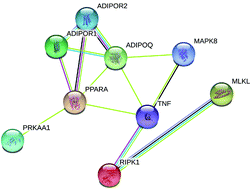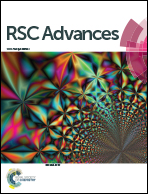Antagonistic effects of selenium against necroptosis injury via adiponectin-necrotic pathway induced by cadmium in heart of chicken†
Abstract
Cadmium (Cd) is one of the most toxic heavy metals having a destructive impact on various organ systems. For example, it induces oxidative stress in heart of chicken. Selenium (Se), in the form of selenoproteins, is known to protect tissues and organs against such heavy metal induced-damage. However, the precise cellular mechanism of the ameliorative role of Se in preventing Cd-induced toxicity in cardiac tissues remains unclear. The aim of this study is to investigate the role of Se in preventing Cd-induced toxicity in the chicken heart and assess the possible cytoprotective mechanism of Se. A total of 128 chickens were divided into four trial groups fed by a standard diet comprising Se, Se+, Cd+, and Se+ + Cd+ for 90 days. qPCR and western blotting were performed to observe the mRNA and protein expression of genes. Correlation analysis (PPI) and heat maps were used for further analysis. The results revealed that the exposure to Cd significantly increased (p < 0.05) the mRNA and protein levels of c-Jun N-terminal kinase (JNK), phosphorylated c-Jun N-terminal kinase (P-JNK), tumor necrosis factor α (TNFα), protein kinase superfamily protein 1 (RIPK1) and mixed lineage kinase domain like pseudokinase (MLKL) in the chicken. On the contrary, the mRNA and protein expression of peroxisome proliferator activated receptor alpha (PPARα), adiponectin (ADIPOQ), adiponectin receptor 1 (AdipoR1), adiponectin receptor 2 (AdipoR2), and adenosine monophosphate-activated protein kinase alpha 1 (AMPKα1) were significantly decreased in the Cd+ group. Furthermore, the mRNA and protein expression levels of PPARα, adiponectin, adipoR1, adipoR2 and AMPK1 were increased (p < 0.05) significantly in the Se+ group. However, the expression of JNK, TNFα and RIPK1 was significantly decreased as compared to that in the group provided with a normal standard diet. Notably, no significant increase in JNK, TNFα, RIPK1 and MLKL expression levels were observed in the chickens provided with a diet comprising Se+ + Cd+, whereas the expression levels of PPARα, adiponectin, adipoR1, adipoR2 and AMPK1 were increased significantly as compared to those in the Cd+ group. These results evidently indicated that Cd could induce severe myocardial damage by activating the necroptosis pathway, whereas Se could play an excellent potential role in preventing Cd-induced myocardial damage through activating adiponectin pathway.

- This article is part of the themed collection: 2017 Review articles


 Please wait while we load your content...
Please wait while we load your content...